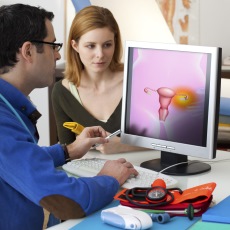
Polycystic Ovary Syndrome
Also called: PCOS, Stein-Leventhal SyndromeMEDICAL ENCYCLOPEDIA
National Institutes of Health
NIH MedlinePlus Magazine

Polycystic ovary syndrome (PCOS) happens when a woman's ovaries or adrenal glands produce more male hormones than normal. PCOS causes cysts (fluid-filled sacs) to grow on the ovaries. Symptoms include
- Irregular menstrual periods
- Infertility
- Pelvic pain
- Excess hair growth on the face, chest, stomach, or thighs
- Weight gain
- Acne or oily skin
- Patches of thickened skin
Women with PCOS are at higher risk of diabetes, metabolic syndrome, heart disease, and high blood pressure.
PCOS is more common in women who have obesity or have a mother or sister with PCOS. To diagnose PCOS, your health care provider may do a physical exam, pelvic exam, blood tests, and an ultrasound.
There is no cure, but diet, exercise, and medicines can help control the symptoms. Birth control pills help women have normal periods, reduce male hormone levels, and clear acne. Treatments for infertility caused by PCOS may include medicines, surgery, and in vitro fertilization (IVF).
NIH: National Institute of Child Health and Human Development
- What Are the Symptoms of Polycystic Ovary Syndrome (PCOS)?
 (National Institute of Child Health and Human Development)Also in Spanish
(National Institute of Child Health and Human Development)Also in Spanish
- Anti-Müllerian Hormone Test
 (National Library of Medicine)Also in Spanish
(National Library of Medicine)Also in Spanish - How Do Health Care Providers Diagnose Polycystic Ovary Syndrome (PCOS)?
 (National Institute of Child Health and Human Development)Also in Spanish
(National Institute of Child Health and Human Development)Also in Spanish
- Treatments to Relieve Symptoms of Polycystic Ovary Syndrome (PCOS)
 (National Institute of Child Health and Human Development)Also in Spanish
(National Institute of Child Health and Human Development)Also in Spanish
- Hirsutism and Polycystic Ovarian Syndrome (American Society for Reproductive Medicine)
- Insulin-Sensitizing Agents and Polycystic Ovarian Syndrome (American Society for Reproductive Medicine)Also in Spanish
- PCOS (Polycystic Ovary Syndrome) and Diabetes (Centers for Disease Control and Prevention)Also in Spanish
- polycystic ovary syndrome: MedlinePlus Genetics
 (National Library of Medicine)
(National Library of Medicine)
- Drug Improves Birth Rates for Women with Ovary Disorder
 (National Institutes of Health)
(National Institutes of Health) - Gene Linked to Excess Male Hormones in Female Infertility Disorder
 (National Institute of Child Health and Human Development)
(National Institute of Child Health and Human Development) - NICHD Research Networks Help Piece Together the Puzzle of Polycystic Ovary Syndrome
 (National Institute of Child Health and Human Development)
(National Institute of Child Health and Human Development)
- ClinicalTrials.gov: Polycystic Ovary Syndrome
 (National Institutes of Health)
(National Institutes of Health)
- Normal Female Reproductive Anatomy
 (National Cancer Institute)
(National Cancer Institute)
- Eunice Kennedy Shriver National Institute of Child Health and Human Development
 (National Institute of Child Health and Human Development)Also in Spanish
(National Institute of Child Health and Human Development)Also in Spanish - womenshealth.gov (Department of Health and Human Services, Office on Women's Health)Also in Spanish
- Oral Contraceptive Pill and PCOS (Children's Hospital Boston)
- Polycystic Ovary Syndrome (For Teens) (Nemours Foundation)
- Polycystic Ovary Syndrome (PCOS) for Teens (Hormone Health Network)Also in Spanish
- Polycystic Ovary Syndrome (PCOS) in Teens: A Guide for Parents and Guardians (Children's Hospital Boston)Also in Spanish
- Polycystic Ovary Syndrome (PCOS): A Guide for Teens (Children's Hospital Boston)Also in Spanish
- Polycystic ovary disease (Medical Encyclopedia)Also in Spanish






















.png)











No hay comentarios:
Publicar un comentario